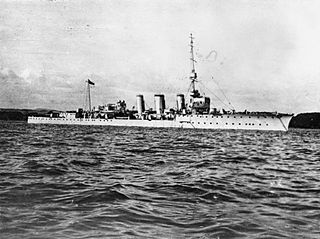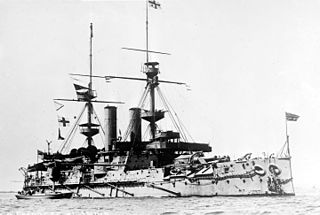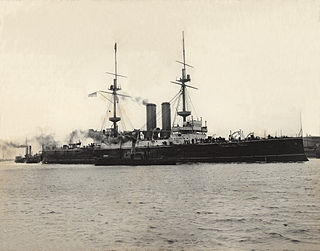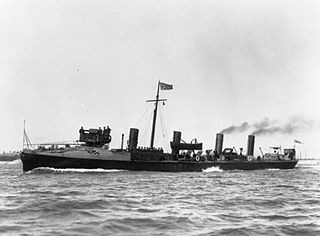
HMS Victorious was one of nine Majestic-class pre-dreadnought battleships of the British Royal Navy. She was armed with a main battery of four 12-inch (305 mm) guns in two twin turrets, and was capable of a top speed of 16 knots. She served primarily on home waters, and participated in the Fleet Review for the Diamond Jubilee for Queen Victoria in 1897. She served briefly in the Mediterranean in 1898 before being transferred to the China Station later that year; Victorious remained in East Asian waters until 1900, when she returned to the Mediterranean.

HMS Magnificent was one of the nine Majestic-class pre-dreadnought battleships of the Royal Navy. She entered service in late 1895 with the Channel Fleet, remaining with the fleet through its subsequent reorganisation into the Atlantic Fleet. In 1905, an explosion caused the deaths of 18 men but she remained in service until 1906, after which she underwent a refit. She served with the Home Fleet for most of her pre-war service.
Twelve ships and two shore establishments of the Royal Navy have been named HMS Defiance. Others have borne the name whilst serving as depot ships and tenders to the establishments:

HMS Andromache was an Apollo-class protected cruiser of the Royal Navy. William Henry White designed her, and she was built at Chatham Dockyard and launched on 14 August 1890. The total cost of construction was £186,234.

HMS Commonwealth, was a King Edward VII-class battleship of the British Royal Navy. Like all ships of the class she was named after an important part of the British Empire, namely the Commonwealth of Australia. Armed with a battery of four 12-inch (305 mm) and four 9.2 in (234 mm) guns, she and her sister ships marked a significant advance in offensive power compared to earlier British battleship designs that did not carry the 9.2 in guns. Commonwealth was built at the Fairfield Shipbuilding and Engineering Company, and was laid down in June 1902, launched in May 1903, and completed in March 1905.

HMS Sutlej was a Cressy-class armoured cruiser built for the Royal Navy around 1900. Upon completion she was assigned to the China Station. In 1906 she became a training ship for the North America and West Indies Station before returning home and being assigned as the flagship of the reserve Third Fleet in 1909. Relieved as flagship in 1910, she remained in reserve until the beginning of World War I in August 1914.

HMS Andromeda was one of eight Diadem-class protected cruisers built for the Royal Navy in the 1890s. Upon completion in 1899, the ship was assigned to the Mediterranean Fleet where she helped to escort a royal yacht during its cruise through the Mediterranean Sea. After a refit, she was assigned to the China Station in 1904 and returned home three years later to be reduced to reserve. Andromeda was converted into a training ship in 1913 and remained in that role under various names until 1956. That year she was sold for scrap and broken up in Belgium, the last Pembroke-built ship still afloat.

HMS Niobe was a ship of the Diadem class of protected cruisers in the Royal Navy. She served in the Boer War and was then given to Canada as the second ship of the newly created Naval Service of Canada as HMCS Niobe. The Naval Service of Canada became the Royal Canadian Navy in August 1911. The ship was nearly lost when she went aground off Cape Sable Island, Nova Scotia overnight 30–31 July 1911. Repairs were completed at the end of 1912 and the ship returned to service in late 1914. During the First World War, Niobe patrolled the approaches to the St. Lawrence River and then joined the Royal Navy's 4th Cruiser Squadron to patrol off New York City. The cruiser returned to Halifax, Nova Scotia on 17 July 1915 and never put to sea again. Niobe was paid off in September and served as a depot ship in Halifax. Damaged in the 1917 Halifax Explosion, she was sold for scrap and broken up in the 1920s.

HMS Aurora was one of seven Orlando-class armoured cruisers built for the Royal Navy in the mid-1880s. The ship spent a brief time in reserve before she was assigned to the Channel Squadron for two years in 1890. In 1893 Aurora became a coast guard ship in Ireland for two years before she was placed in reserve again. The ship recommissioned in 1899 for service on the China Station and some of her crew participated in the Battle of Tientsin in 1900 during the Boxer Rebellion. Aurora returned home two years later and was again reduced to reserve. She was taken out of service in 1905 and sold for scrap on 2 October 1907.

HMS Cordelia was a C-class light cruiser built for the Royal Navy during World War I. She was one of six ships of the Caroline sub-class and was completed at the beginning of 1915. The ship was assigned to the 1st and 4th Light Cruiser Squadrons (LCS) of the Grand Fleet for the entire war and played a minor role in the Battle of Jutland in mid-1916. Cordelia spent most of her time on uneventful patrols of the North Sea. She spent most of 1919 as a training ship before she was recommissioned for service with the Atlantic Fleet in 1920. The ship was placed in reserve at the end of 1922 and was sold for scrap in mid-1923.

HMS Sirius was an Apollo-class cruiser of the British Royal Navy which served from 1892 to 1918 in various colonial posts such as the South and West African coastlines and off the British Isles as a hastily converted minelayer during the First World War.

HMS Empress of India was one of seven Royal Sovereign-class pre-dreadnought battleships built for the Royal Navy during the 1890s. The ship was commissioned in 1893 and served as the flagship of the second-in-command of the Channel Fleet for two years. She was transferred to the Mediterranean Fleet in 1897, during which time Empress of India was assigned to the International Squadron blockading Crete during the uprising there. She returned home in 1901 and was briefly assigned as a coast guard ship in Ireland before she became the second flagship of the Home Fleet. The ship was reduced to reserve in 1905 and accidentally collided with the submarine HMS A10 the following year. Empress of India was taken out of service in early 1912 and accidentally struck a German sailing ship while under tow. She was sunk as a target ship in 1913.

HMS Ramillies was a Royal Sovereign-class pre-dreadnought battleship of the Royal Navy, named after the Battle of Ramillies. The ship was built by J. & G. Thompson at Clydebank, starting with her keel laying in August 1890. She was launched in March 1892 and commissioned into the Mediterranean Fleet as flagship the following October. She was armed with a main battery of four 13.5-inch guns and a secondary battery of ten 6-inch guns. The ship had a top speed of 16.5 knots.

HMS Barfleur was the second and last of the Centurion-class pre-dreadnought battleships built for the Royal Navy in the 1890s. Intended for service abroad, they exchanged heavy armour and a powerful armament for high speed and long range to counter the foreign armoured cruisers then being built as commerce raiders and were rated as second-class battleships.

HMS Glory was a pre-dreadnought battleship of the British Royal Navy and a member of the Canopus class. Intended for service in Asia, Glory and her sister ships were smaller and faster than the preceding Majestic-class battleships, but retained the same battery of four 12-inch (305 mm) guns. She also carried thinner armour, but incorporated new Krupp steel, which was more effective than the Harvey armour used in the Majestics. Glory was laid down in December 1896, launched in March 1899, and commissioned into the fleet in November 1900.

HMS Vengeance was a pre-dreadnought battleship of the British Royal Navy and a member of the Canopus class. Intended for service in Asia, Vengeance and her sister ships were smaller and faster than the preceding Majestic-class battleships, but retained the same battery of four 12-inch (305 mm) guns. She also carried thinner armour, but incorporated new Krupp steel, which was more effective than the Harvey armour used in the Majestics. Vengeance was laid down in August 1898, launched in July 1899, and commissioned into the fleet in April 1902.

HMS Highflyer was the lead ship of the Highflyer-class protected cruisers built for the Royal Navy in the 1890s. She spent her early career as flagship for the East Indies and North America and West Indies Stations. She was reduced to reserve in 1908 before again becoming the flagship in the East Indies in 1911. She returned home two years later and became a training ship. When World War I began in August 1914, she was assigned to the 9th Cruiser Squadron in the Central Atlantic to intercept German commerce raiders and protect Allied shipping.

HMS Ferret was a Ferret-class destroyer which served with the Royal Navy from 1893 and was sunk in 1911.

HMS Dryad was the name ship of the Dryad-class torpedo gunboats. She was launched at Chatham Dockyard on 22 November 1893, the first of the class to be completed. She served as a minesweeper during World War I and was broken up in 1920.

The Arrogant-class cruiser was a class of four protected cruisers built for the British Royal Navy at the end of the 1890s. One ship, HMS Gladiator, was lost following a collision with a merchant ship in 1908, while HMS Vindictive saw active service in the First World War, taking part in the Zeebrugge Raid in April 1918 before being sunk as a blockship during the Second Ostend Raid in May 1918.



















